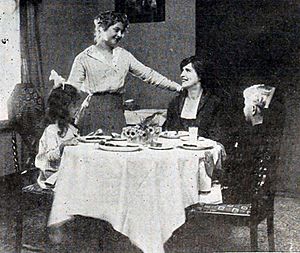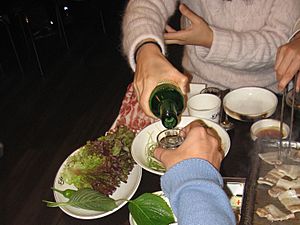Table manners facts for kids
Table manners are the unwritten rules about how to behave when you're eating, especially when you're with other people. These rules can also include how to use your forks, knives, and spoons. Different cultures around the world have their own special ways of doing things at the table. How strictly these rules are followed can depend on each family or group.
Contents
Table Manners in Western Europe
In countries like the United Kingdom and other parts of Western Europe, there are some common table manners.
Starting the Meal
Usually, the person who is hosting the meal (the host or hostess) takes the first bite. This happens after all the food for that part of the meal has been served and everyone is sitting down. Sometimes, in religious homes, people might say a prayer before eating. At dinner parties, guests might thank the host for the food. It's considered polite to wait until everyone at your table has their food before you start eating.
Using Napkins
Your napkin should go on your lap, not tucked into your clothes. Use it only to wipe your mouth. If you need to leave the table during the meal, place your napkin unfolded on your chair. When you're completely finished eating, place it unfolded on the table next to your plate.
Holding Utensils
When you're using a knife and fork, hold the fork in your left hand and the knife in your right. The fork usually points down, and you use the knife to cut food or help push it onto your fork. If you're not using a knife, you can hold the fork with its prongs pointing up. Always chew your food with your mouth closed. It's considered very rude to talk when you have food in your mouth. Also, try not to lick your fingers or eat too slowly.
Seasoning Your Food
It's a good idea to taste your food before adding salt or pepper. Adding seasonings before you've even tried the food can be seen as a bit rude to the cook. It might make them think you don't trust their cooking!
Bread and Butter
When you have butter, cut a piece from the butter dish with a butter knife and put it on your small side plate. Don't spread it directly onto your bread from the main dish. This helps keep the butter clean for everyone. Bread rolls should be torn into small, bite-sized pieces with your hands. Then, butter each small piece using the butter from your side plate. Don't use bread to dip into soup or sauces.
Drinks
It's fine to pour your own drink, but it's even more polite to offer to pour drinks for the people sitting next to you.
Reaching and Noise
Don't reach across someone's plate to grab food or other items. Always ask for things to be passed to you. If someone asks you to pass something, send it directly to them or to the next person who can pass it along. It's also rude to slurp your food, eat loudly, or make noise with your cutlery. Keep your elbows off the table.
When You're Finished
When you're done eating, whether your plate is empty or not, you can signal this by placing your knife and fork together on your plate. You can put them at the 6 o'clock position (pointing up) or the 4 o'clock position (pointing towards 10 o'clock). The fork prongs should face up. If you have a napkin, fold it loosely and place it to the left of your plate. This tells waiters in restaurants that you're finished and they can clear your plate. At home, children are often expected to ask permission to leave the table after a meal.
Mobile Phones
If your phone rings or you get a text message during a meal, try to ignore it. If it's an emergency, excuse yourself from the table, leave the room, and take the call or read the message quietly so others can't hear. It's considered rude to put your phone, keys, bag, or wallet on the dinner table.
Table Manners in North America
In North America, modern table manners try to keep things simple.
Utensils and Table Settings
You should only set out the forks, knives, and spoons that will actually be used for the meal. For formal dinners, a tablecloth should hang about 10-15 inches over the table's edge. For less formal meals, placemats are fine.
Hats and Distractions
Hats (for men and unisex styles) should not be worn at the table. Phones and other distracting items should not be used. Reading at the table is usually only okay at breakfast, unless you're eating alone. If something urgent comes up, apologize and step away from the table to handle it.
Removing Food from Your Mouth
If you need to remove something from your mouth, like a fruit pit or a small bone, it should come out the same way it went in. For example, if you ate an olive with your hand, you can remove the pit with your hand. If you ate it with a fork, put the pit back onto your fork inside your mouth, then place it on your plate. Never spit things into your napkin, especially a cloth one, as it might fall out later. If you simply don't like a food, it's best to swallow it.
Eating Soup
When eating soup, always push your spoon away from you, not towards you. Don't slurp your soup. This rule comes from older ideas that pulling the spoon towards you looked like you were very hungry or greedy.
Fork Styles
You can use your fork in two main ways:
- American style: Hold the fork in your left hand while cutting, then switch it to your right hand to pick up food.
- European Continental style: Keep the fork in your left hand the whole time.
Napkin Placement
Only leave your napkin on your chair if you are leaving the table for a short time. When you are completely finished with the meal, place your napkin loosely on the table to the left of your plate.
Table Manners in India
In India, dining etiquette has its own unique customs.
Starting and Finishing the Meal
In formal settings, the host will ask the guests to begin eating. Generally, you shouldn't leave the table before the host or the oldest person has finished their food. It's also considered impolite to leave without asking their permission. Usually, everyone waits until the last person finishes, and then everyone leaves the table together.
Using Your Hands
A very important rule in India is to use your right hand when eating or receiving food. It's not polite to touch shared serving utensils with the hand you're eating with. So, if you eat with your right hand, use your left hand to serve yourself from shared dishes. Washing your hands before and after eating is very important.
Food Portions and Waste
Take small amounts of food at a time to make sure nothing is wasted. It's considered important to finish everything on your plate to show respect for the food. Traditionally, you should eat the food as it's served, without asking for salt or pepper. However, nowadays, it's more acceptable to ask for them if you prefer.
Eating Pace and Sounds
Don't play with your food. Eating at a moderate pace is important: eating too slowly might suggest you don't like the food, and eating too quickly is considered rude. It's generally acceptable to burp or slurp while eating at the table. Staring at someone else's plate is also rude. Try not to make sounds while chewing; close your mouth and chew at a moderate pace.
Distractions
At the dining table, avoid distractions. Answering phone calls, sending messages, or using inappropriate language are considered rude, especially when older people are present.
Table Manners in China
Seating and serving customs are very important in Chinese dining.
Seating and Serving
Diners should not sit down or start eating before the host or the guest of honor has done so. When everyone is seated, the host will offer to pour tea, starting with the oldest person. The youngest person is served last, as a sign of respect for elders.
Chopstick Etiquette
Just like in Western cultures, shared utensils (chopsticks and spoons) are used to move food from common dishes to your own bowl or plate. It's considered rude and unhygienic to use your own chopsticks to pick up food from shared bowls if serving utensils are available. Other rude things to avoid with chopsticks include:
- Playing with them.
- Separating them (like holding one in each hand).
- Sticking them into food.
- Standing them straight up in a plate of food (this is very rude, as it looks like incense sticks used at funerals).
You can lift your rice bowl with one hand to scoop rice into your mouth with chopsticks. It's also rude to search for a specific piece of food on a shared plate instead of just taking the piece closest to you. This shows fairness and sharing.
Finishing Food
You should never take the last piece of food from a shared dish without asking permission. If someone offers you the last bit of food, it's considered rude to say no. It's good manners to try not to leave any food on your plate or in your bowl. Sometimes, fancy restaurants might not offer soy sauce or other seasonings. This is because they believe the food is perfectly made and doesn't need anything extra.
Table Manners in Korea
In Korea, meals often begin when the oldest or most respected person at the table starts eating.
Starting and Finishing
Before eating, it's polite to say you're going to enjoy the meal. And when you're done, you should express that you enjoyed it. If a dish needs more cooking or serving at the table, the youngest or lowest-ranked adult usually does this. When serving food and drinks, you serve from the oldest or highest-ranked person down to the youngest or lowest-ranked.
Eating with Utensils
Rice is always eaten with a spoon, never with chopsticks, in formal settings. It's considered rude to pick up your plate or bowl and bring it to your mouth. Usually, you'll have a bowl of soup on your right and a bowl of rice on your left. You'll have chopsticks and a spoon. Common chopstick rules apply, but rice is generally eaten with the spoon. Other side dishes (called Banchan) are placed around the table. If you're using a spoon, you can put a side dish on your spoonful of rice before eating it. With chopsticks, you eat the side dish directly.
Sharing Food
Just like in China, you shouldn't take the last piece of food from a shared dish without asking permission. But if someone offers you the last bit, it's rude to refuse. Bowls of rice or soup should stay on the table while you're eating, except for large bowls of Korean noodle soup. Slurping noodles and soup is generally acceptable. It's also not uncommon to chew with your mouth open.
Serving Drinks
If drinks are served with the meal, the oldest or highest-ranked person usually makes a toast first, and people clink glasses before drinking. This clinking often happens throughout the meal. A host should never pour a drink for themselves. It's also considered rude to drink alone. Instead, keep pace with others, and both serve and be served drinks. Always serve drinks to older and higher-ranked people using both hands. Younger or lower-ranked people might turn their face away from others when drinking.
Images for kids
See also
 In Spanish: Etiqueta sobre la mesa para niños
In Spanish: Etiqueta sobre la mesa para niños





